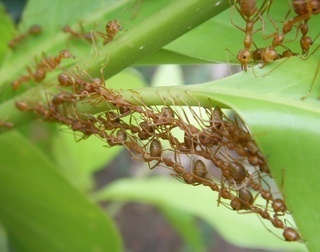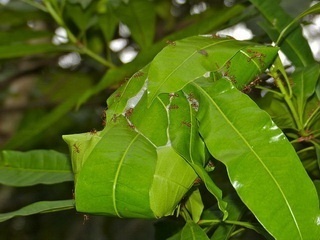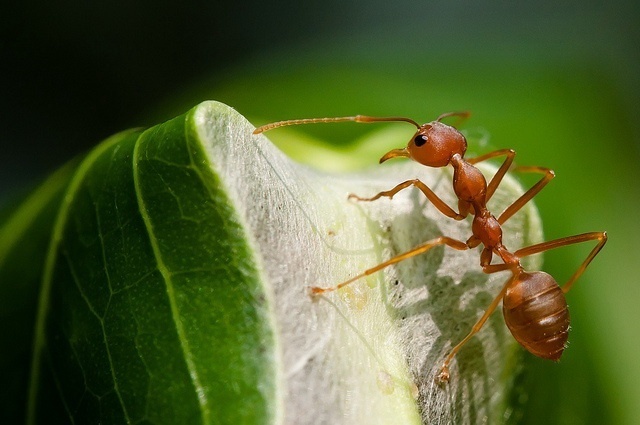Weaver ant will rescue nestmate from spider web
Floria Uy and colleagues show that workers of the weaver ant care about their nestmates: when an ant gets entangled in a spider’s web, others are willing to help it. The ants were already known for their ‘living sewing machine’.
The weaver ant or green tree ant, Oecophylla smaragdina, is common in the tropical parts of Asia and Australia. Its presence is clearly visible because of its nests, which stand out as balls of leaves in bushes and trees. The arboreal nests are the result of a special piece of group work, involving not only workers, but also larvae.
 To construct a nest, the ants must glue the leaf edges together. Workers will line up, grasp the edges of two leaves (or two pieces of a long leaf) and draw them together. If the distance between the leaf edges is large, they grab each other and form living chains to bridge the gap. By then shortening the chain, they pull the leaf edges towards each other.
To construct a nest, the ants must glue the leaf edges together. Workers will line up, grasp the edges of two leaves (or two pieces of a long leaf) and draw them together. If the distance between the leaf edges is large, they grab each other and form living chains to bridge the gap. By then shortening the chain, they pull the leaf edges towards each other.
Living sewing machine
They then attach the edges firmly to each other with a ‘living moveable sewing machine’, as described by Ross Crozier. While many workers hold the leaf edges, others join with a mature larva between their jaws. The workers stimulate the larvae to spin a silk thread and move them zigzag between the leaf edges, stitching the leaves together.
The workers stimulate the larvae to spin a silk thread and move them zigzag between the leaf edges, stitching the leaves together.
In many ant species, larvae spin silk to make a cocoon in which they pupate. But in the weaver ant, their silk is used for nest construction.
A colony of weaver ants consists of multiple nests in several trees; many ants are running on trails between these nests. In peripheral nests of the colony, soldiers live that guard the boundaries of the territory and defend it against conspecific ants from foreign colonies. On average, a colony will live for eight years and can have as many as half a million inhabitants.
That is a lot, and you would be inclined to think that an ant’s life does not matter that much.
Yet, the ants are concerned when a nestmate that is in danger, Floria Uy and colleagues now show. They discovered a second example of complex cooperation within this species.
Ant in distress
If a weaver ant is trapped in a spider’s web, conspecifics may bite the threads of the web and free the victim, as Uy showed. But an alternative scenario is also possible: ants may attack a worker that is entangled in a spider’s web and kill it. When will the ants rescue a conspecific, and when will they kill it?
Uy, who conducted experiments on the Solomon Islands, put a number of ants next to an ant trail after having wrapped them in spider’s silk; in some cases, the victim was a nestmate of the ants on the trail, in other cases it was from a foreign colony.
She found that ants will always help a nestmate in distress. But for ants from a different colony, the outcome is uncertain: some are rescued, others are killed. That some of them are killed is to be expected: to the residents on the trail, they are intruders and accordingly, they are treated aggressively. The fact that some non-nestmates in distress are helped instead is surprising.
It may be a mistake, the researchers hypothesize. In the study area, ants from neighbouring colonies have a greater chance of being rescued than ants from distant colonies. Ants recognize nestmates and colony mates by smell, and neighbouring colonies may have a rather similar odour.
Willy van Strien
Photos:
Large: weaver ant on nest. Rushen (via Flickr, CC BY-SA 2.0)
Small, middle: workers building the nest. Sean.hoyland (Wikimedia Commons, Public Domain)
Small, below: nest with weaver ants. Bernard DUPONT (via Flickr, CC BY-SA 2.0)
Watch weaver ants building a nest
Sources:
Uy, F.M.K., J.D. Adcock, S.F. Jeffries & E. Pepere, 2018. Intercolony distance predicts the decision to rescue or attack conspecifics in weaver ants. Insectes Sociaux, online Nov. 3. Doi: 10.1007/s00040-018-0674-z
Crozier, R.H., P.S. Newey, E.A. Schlüns & S.K.A. Robson, 2010. A masterpiece of evolution – Oecophylla weaver ants (Hymenoptera: Formicidae). Myrmecological News 13: 57-71
